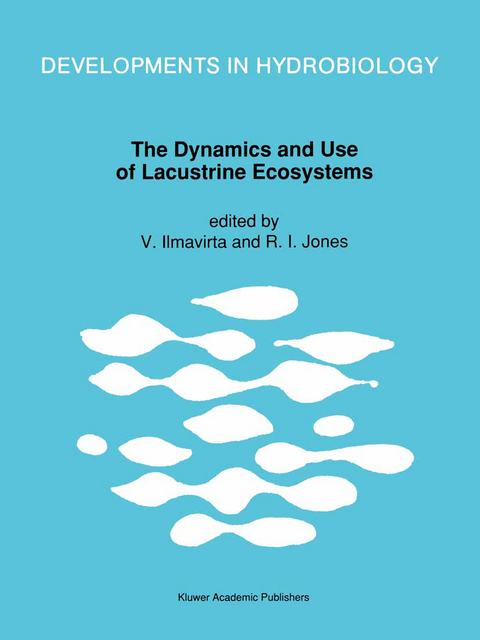
The Dynamics and Use of Lacustrine Ecosystems
Springer (Verlag)
978-94-010-5218-4 (ISBN)
Limnology is increasingly concerned with water supply and the relation of man to aquatic environments. Without the continued availability of pure water, all progress in technology and other fields of human life will be to no avail. The global problems concerning clear water are already extremely pressing. More limnology knowledge is needed to solve these problems. The responsibility of man to save water and to take more intensive care of the environment is raised in many of the papers, in this book. This emphasizes the necessary and unquestionable relevance of limnology to human society. Too often the abuse of water usage reflects the neglect of scientific results. Limnologists have a responsibility to ensure that administrators understand what is going on.
The coverage of the book is wide, including papers on microbiology to engineering sciences. The biology of waters is handled at both species and ecosystem levels. The geographical distribution of topics ranges from the tropics to northern temperate areas. In fact, limnology is increasingly becoming a science which is, rightly, relevant to everyday life, not just an academic subject.
Trends in Finnish limnology during 1940-1989.- Clean water: a fading resource.- Uses, abuses and management of lakes and rivers.- Extracellular enzymes in a small polyhumic lake: origin, distribution and activities.- Significance of bacterial ectoenzymes in aquatic environments.- Kinetics of amino acids mineralization by a pond sediment bacterial community.- Microbial ecology of planktonic filamentous phototrophic bacteria in holomictic freshwater lakes.- Population dynamics of phototrophic bacteria in three basins of Lake Banyoles (Spain).- Estimating photosynthetically available radiation into open and ice-covered freshwater lakes from surface characteristics; a high transmittance case study.- Phosphorus transformations in the epilimnia of small humic forest lakes.- Differential luxury phosphate response of planktonic algae to phosphorus removal.- Temporal changes in biomass specific photosynthesis during the summer: regulation by environmental factors and the importance of phytoplankton succession.- Spatial changes of phytoplanktonic size spectra in Lake Biwa.- Phytoplankton and submerged macrophytes in the aquatic ecosystems of the Danube Delta during the last decade.- Phytoplankton and Zooplankton community structure after nutrient additions to the oligotrophic Lake Hecklan, Sweden.- Respiratory electron transport system (ETS) — activity of the plankton and sediment in Lake Balaton (Hungary).- Population dynamics of Bosmina longirostris (Crustacea: Cladocera) in Lake Kariba, Zimbabwe.- Plankton ecology in an ice-covered bay of Lake Michigan: utilization of a winter phytoplankton bloom by reproducing copepods.- The role of zoobenthos in energy flow in deep, oligotrophic Lake Thingvallavatn, Iceland.- Life history of Corophium curvispinum G. O. Sars (Crustacea,Amphipoda) living on macrophytes in Lake Balaton.- Experimental estimation of the food intake of larval vendace (Coregonus albula L.) under field conditions.- Food, growth, habitat, and community interactions of young-of-the-year burbot, Lota lota (Linn.), in a Precambrian Shield lake.- The response of burbot (Lota lota) to change in lake trout (Salvelinus namaycush) abundance in Lake Opeongo, Ontario.- Demography of spawning grayling (Thymallus arcticus) in the Beaverlodge River, Alberta.- An evaluation of the quality of fall-fingerling Atlantic salmon (Salmo salar L.) released to natural lacustrine nursery areas in Newfoundland, Canada.- Trophic state and its implications for natural reproduction of salmonid fish.- Ecological release in feeding behaviour: the case of bluegills in Japan.- Whitefish stocking in acidified lakes: ecological and physiological responses.- Can ecological theory be used to improve water quality?.- Indirect effects offish community structure on submerged vegetation in shallow, eutrophic lakes: an alternative mechanism.- Regulation of the development and species dominance of summer phytoplankton in Lake Vesijärvi: predictability of enclosure experiments.- Effects offish density on planktonic communities and water quality in a manipulated forest pond.- Impacts of bleak (Alburnus alburnus) and roach (Rutilus rutilus) on water quality, sedimentation and internal nutrient loading.- Lacustrine profundal meiobenthos as an environmental indicator.- Mass balance models for elongated lakes.- Transport processes in a sound of a large lake.- The benthic boundary layer approach and its application to Lake Päijänne, Finland.- Interpretation of mixed sediment profiles by means of a sediment-mixing model and radioactive fallout.- Evaluation of amodel-based method for designing water quality observations.- The effects of reduced phosphorus and nitrogen loading on phytoplankton in Mondsee, Austria.- Changes in water quality in Lake Päijänne following decrease of effluent load from the pulp and paper industry in 1969-1989.- Reproductive success of Coregonus species in areas loaded by effluents from paper mills.- Effects of paper mill effluents on the fish fauna of stony shores of Lake Päijänne.- The eutrophication of shallow coastal lakes in southwest England — understanding and recommendations for restoration, based on palaeolimnology, historical records, and the modelling of changing phosphorus loads.- The conservation status of athalassic lakes in New South Wales, Australia.- Effects of waterfowl on water quality.- Organic matter in the River Krutynia (Masurian Lakeland, Poland).- Effects of forest clear-cutting and soil disturbance on the biology of small forest brooks.- The effects of forest clear-cutting and scarification on the water quality of small brooks.- Total organochlorine and organobromine in Finnish water courses.- Concluding remarks I. Limnology now and in the future.- Concluding remarks IL A Finnish perspective.
| Reihe/Serie | Developments in Hydrobiology ; 79 |
|---|---|
| Zusatzinfo | IX, 498 p. |
| Verlagsort | Dordrecht |
| Sprache | englisch |
| Maße | 195 x 260 mm |
| Themenwelt | Naturwissenschaften ► Biologie ► Limnologie / Meeresbiologie |
| Naturwissenschaften ► Biologie ► Ökologie / Naturschutz | |
| ISBN-10 | 94-010-5218-2 / 9401052182 |
| ISBN-13 | 978-94-010-5218-4 / 9789401052184 |
| Zustand | Neuware |
| Haben Sie eine Frage zum Produkt? |
aus dem Bereich


